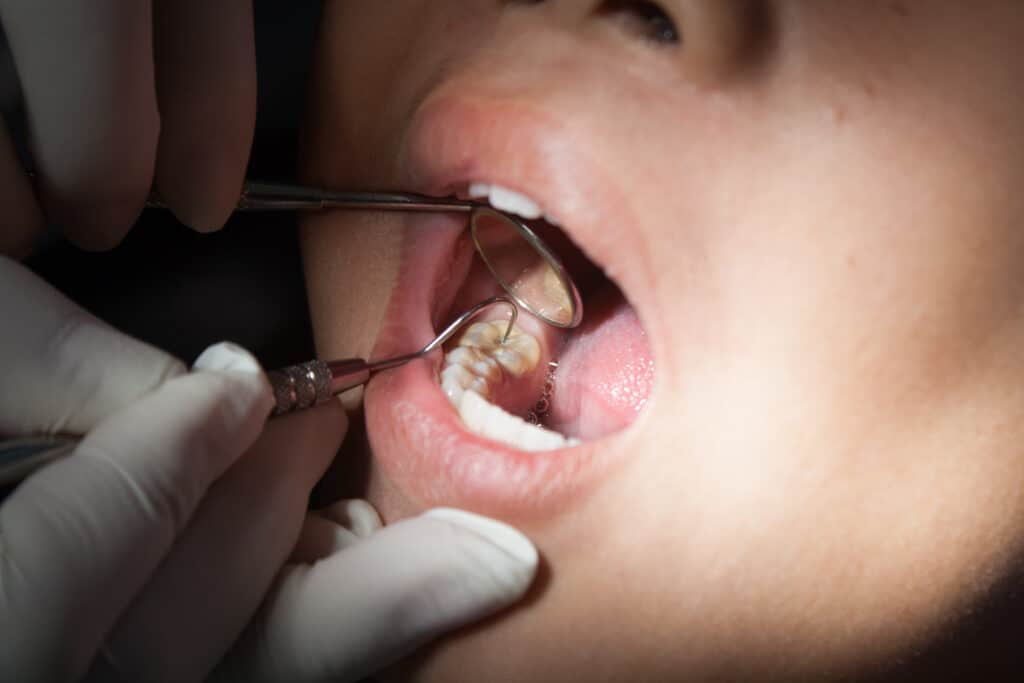Step-by-Step Process of Applying Dental Sealants
Cassell Dentistry in Mission Valley, CA aims to help our patients prevent dental problems before they start. Such as cavities. That’s exactly where dental sealants come in.
Getting dental sealants is simple and practically pain free. They’re also a preventative treatment that is both affordable and often covered by dental insurance.
What Are Dental Sealants?
Dental sealants are special protective layers designed to safeguard your teeth while they’re still healthy. Particularly the molars and premolars (back teeth,) which are usually more prone to cavities. These thin, protective coatings are made of a plastic-like material and are bonded into the narrow grooves on the chewing surfaces of your back teeth. Even with good oral hygiene, these grooved and pitted surfaces are prone to trapping food particles and harboring bacteria. Sealants act as a barrier, sealing off the deep and narrow crevices, preventing bacteria and food from settling in and causing cavities.
Who Can Benefit from Dental Sealants?
Children and teenagers are typically the primary candidates for sealants because their newly erupted permanent teeth are most susceptible to decay. However, adults with healthy molars and premolars can also benefit from this preventive treatment.
Since sealants are extremely affordable, they’re worth the investment considering the other alternative is treating a cavity and paying for restorative treatment after decay has formed.
For someone with a history of cavities or who tends to be more prone to dental decay, sealants can be a cost-effective step to protect your teeth. Just keep in mind that sealants are most effective when applied as soon as the permanent molars come in, which happens to be around the ages of 6 and 12, respectively.
The Process of Getting Dental Sealants
Applying dental sealants is a straightforward and painless process. It can usually be completed during you or your child’s routine dental check-up and does not require any drilling or removal of tooth structure. Here’s a step-by-step breakdown of what to expect:
Step 1: Cleaning and Preparation
Before the sealant application, we will thoroughly clean the teeth being sealed. This step ensures that no food particles or bacteria are trapped beneath the sealant, maximizing its effectiveness.
Step 2: Etching the Tooth Surface
Next, we’ll isolate the tooth with cotton or a dental dam. Then, a special etching gel is applied to the chewing surface of the tooth. This gel roughens the enamel ever so slightly, creating a better bonding surface for the sealant.
Step 3: Rinsing and Drying
After a brief application of the etching gel, the tooth is rinsed and dried to remove any remaining gel. The tooth must remain completely dry, so a cotton roll may be added to ensure the tooth stays isolated.
Step 4: Applying the Sealant
Now, the dental sealant is applied to the prepared tooth. It’s in a liquid form, which allows it to flow into the deep grooves and fissures.
Step 5: Curing the Sealant
To harden and bond the sealant to the tooth, a special curing light is used. This process usually takes only a few seconds per tooth.
Step 6: Evaluation and Final Adjustments
Once the sealant is cured, we will check to ensure that it has properly bonded and covers all the necessary areas. If any adjustments are needed, they will make them at this stage.
The entire process usually only takes about five minutes at most.
Can Dental Sealants Be Placed on Existing Cavities?
Dental sealants are a preventive measure and are not intended to treat existing cavities. They are most effective when applied to healthy teeth with no signs of decay. Trapping a cavity under your sealant may allow the decay to spread.
Do Dental Sealants Require Any Special Care?
One of the great advantages of dental sealants is that they are easy to maintain. Continue to brush your teeth at least twice a day and floss daily to remove plaque and food particles from all tooth surfaces, including those with sealants. Unlike fillings, sealants aren’t permanent. They can sometimes come off of your teeth, especially if you’re chewing very sticky textures or ice. Avoid things like taffy or caramel in those areas. Be sure to see our dentist in Mission Valley for regular checkups so that your sealants can be touched up if needed.
Schedule Your Appointment Today
Dental sealants are an excellent investment in your and your child’s future oral health. To learn more about these preventative treatments, call Cassell Dentistry in Mission Valley today!

